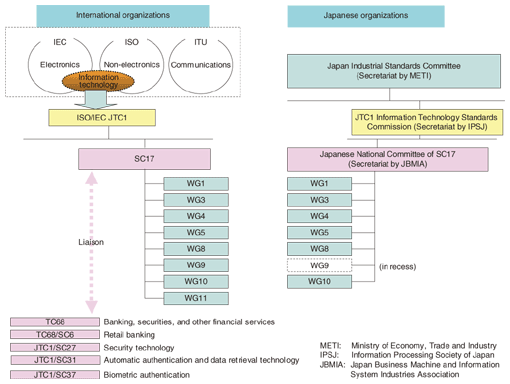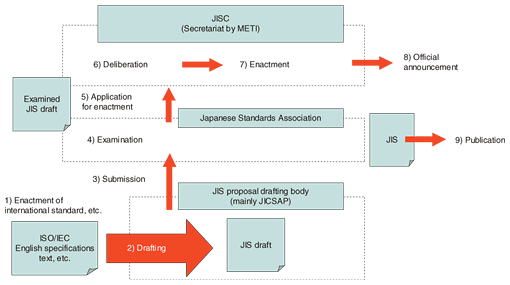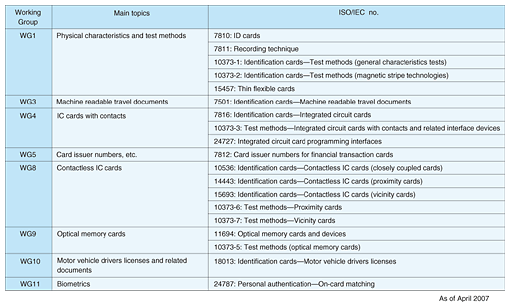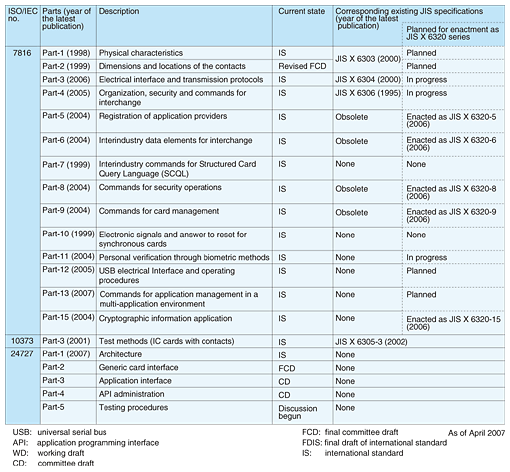 |
|||||||||||||||||||||||||||||
|
|
|||||||||||||||||||||||||||||
|
Global Standardization Activities Vol. 5, No. 6, pp. 42–48, June 2007. https://doi.org/10.53829/ntr200706gls Trends in ISO/IEC Standardization of IC Card TechnologyAbstractThis article describes trends in the standardization of technology related to IC cards (cards containing integrated circuits), focusing on ISO/IEC activities (ISO: International Organization for Standardization, IEC: International Engineering Consortium). It also describes NTT's contributions to those activities.
1. IntroductionIC cards, which incorporate IC (integrated circuit) chips, are overtaking and replacing previous cards that used other data storage methods. The card, reader/writer, and terminal that constitute a card system and the software running on those devices are usually supplied by multiple vendors, so maintaining compatibility is indispensable. In recent years, the use of one card for multiple services has gradually increased, so the standardization of technical specifications has become more and more important for interoperability. 2. Relationships among international and Japanese organizationsThe standardization organizations concerned with IC card technology are shown in Fig. 1. The fields of electronics, non-electronics, and communications are handled by IEC (International Engineering Consortium) [1], ISO (International Organization for Standardization) [2], and ITU (International Telecommunication Union), respectively. IC card technology is categorized as information technology, so a Joint Technical Committee (JTC) that extends across both ISO and IEC has been formed to lead international standardization in that field. 17 subcommittees (SCs) have been formed within ISO/IEC JTC1. Matters related to IC cards are handled by SC17. It comprises eight working groups (WGs) that deal with elemental technology and specific applications. SC17 also cooperates with other relevant committees (e.g., JTC1/SC31 and JTC1/SC37).
In Japan, the Japanese National Committee of SC17 has been established as a counterpart to JTC1/SC17. The subordinate WGs have about the same structure as those of the international organization. They discuss the drafts proposed to JTC1/SC17 by various countries and handle the submission of proposals from Japan to the international standards organizations. 3. International standards and Japanese standardsUnder the agreement with WTO/TBT (World Trade Organization, Technical Barriers to Trade), new Japanese specifications should conform to any existing international standard specifications established by ISO, etc. Japanese Industrial Standard (JIS) specifications concerning IC cards are also in principle set to be consistent with ISO/IEC specifications. The process of setting JIS specifications is illustrated in Fig. 2. First, the JIS proposal drafting body draws up draft JIS specifications that correspond to ISO/IEC specifications. The draft then goes to the Japanese Standards Association for review and revision, after which it is submitted to the Japanese Industrial Standards Committee (JISC). Next, the JIS draft is discussed by JISC and sent to the appropriate Ministry for enactment (for IC card technology, this is the Ministry of Economy, Trade and Industry).
The primary leader of IC card system standardization activities in Japan is JICSAP (Japan IC Card System Application Council ) [3]. JICSAP not only drafts JIS proposals, but also sets the JICSAP IC card specifications for IC card implementation based on the circumstances of use in Japan. To improve the interoperability of IC cards from different manufacturers, JICSAP drafted a JIS proposal that included the JICSAP IC card specifications and the IC card specifications used in Japan for train passes and other such purposes. In 2005, the proposal was adopted as the JIS X 6319 series. NTT has greatly contributed to JICSAP activities related to the drafting of JIS proposals and setting of JICSAP IC card specifications by providing Chairpersons and Editors of the WGs. The established international standards are, in principle, reviewed every five years. The JIS specifications are also revised accordingly. 4. Overview of SC17 WG activitiesThe WG topics and internationals standard specifications are listed in Table 1 and the activities of each WG are summarized below [4].
WG1 deals with physical characteristics and physical testing methods of identification cards (common to plastic, magnetic, and IC media). WG3 deliberates on the specifications of machine readable travel documents (referred to as e-passports). The e-passport specifications are based on the specifications established by the ICAO (International Civil Aviation Organization) and have become the international standard. WG 4 deals with the full range of specifications for IC cards that have contacts (pins), from physical specifications such as pin position to upper-layer matters like commands and application downloading. WG5 handles specifications concerning the number identifying the issuer of financial transaction cards. The central task is revision of existing specifications. WG8 generally deliberates on the communication specifications of contactless IC cards. Current activities center around reviewing existing specifications. WG9 deliberates on optical memory card specifications. However, as companies in Japan are cutting back on or ceasing to use optical cards, the domestic committee is in recess. WG10 deliberates on specifications for the items on the surface of the driver's license, physical characteristics such as surface layout, data structure, and other electronic recording methods, and specifications for encryption, etc. WG11 studies the application of biometric authentication technology to IC cards. In Japan, the Japanese National Committee of WG 4 deliberates these specifications. The status of activities of two of these WGs are explained below. 4.1. SC17/WG4 activitiesSC17/WG4 studies the physical characteristics, transfer protocols, IC card common command functions (including security functions), biometric authentication, and terminal middleware of IC cards that operate through contacts. Previously, the ISO/IEC 7816 series was a main subject of deliberation, but recently WG4 has also taken up other topics. Two that deserve particular mention are ISO/IEC 7816-13 IC and ISO/IEC 24727. These cover card application downloading methods for response to the demand in recent years for multi-use IC cards (7816-13) and the interface for terminal applications to access the IC card (24727). ISO/IEC 7816-13 has become the international standard, with the existing major standards (MULTOS [5], GlobalPlatform [6], and NICSS [7]) having a major effect on specifications concerning commands for managing multiple applications (IC card application download and installation, etc.). MULTOS is being studied by MAOSCO, an international consortium of companies from various industries formed to promote widespread use of the MULTOS specifications and manage their development. MAOSCO is operated and managed by the British firm MAOSCO, Ltd. under Master Card International, Inc. GlobalPlatform is an organization founded on VISA Open Platform technology. The most recent specifications (GlobalPlatform Card specification v2.2) can implement the NICSS and MULTOS systems as well as the previous GlobalPlatform system [8]. NICSS (Next Generation IC Card System Study group) is an organization established to develop and promote a common platform for next-generation IC cards in Japan's public sector. The objectives of NICSS are common specifications for IC cards to be introduced in relevant government ministries and the sharing of information with those ministries. That system has had a major effect on administration projects in Japan. NTT developed PKI-based multiple application management technology (PKI: public key infrastructure) [9] and has made important contributions to the NICSS-Framework and Reference Specifications, eEurope Smart Card Charter Standard [10], and the most recent GlobalPlatform card specifications (GlobalPlatform Card Specification v2.2) [11] towards the construction of an open IC card system. These activities have affected decisions concerning the ISO/IEC 7816-13 specifications. An organization that has had a strong influence on the interface specifications under deliberation as the ISO/IEC 24727 series is the National Institute of Standards and Technology (NIST). NIST has set specifications for the Government Smart Card Interoperability Specification (GSC-IS) terminal middleware and has actively participated in deliberations on the ISO/IEC 24727 series, so it has a major influence in this area. Comité Européen de Normalisation (CEN) [12] is another standardization organization that influences ISO/IEC activities. The JIS specifications that correspond to the ISO/IEC 7816 series currently have numbers divided according to part, but the plan for the future is to integrate the order according to the final specifications, after revisions have been completed by JTC1, as the JIS X 6320 series (Table 2).
4.2. SC17/WG8 activitiesInternational standards concerning contactless IC cards are categorized into three types according to the distance at which they are operate: closely coupled (about 2 mm between IC card and reader/writer), proximity (about 10 cm), and vicinity (about 70 cm). Of those types, specifications for the proximity type, which is used for the resident card, IC driver's license, and other such applications were set as the ISO/IEC 14443 series in 2001 [13]. As many IC cards and reader/writers complying with ISO/IEC 14443 have been widely deployed, a large demand for their interoperability has arisen. Therefore, the compatibility of IC cards and reader/writers is an important factor in the revision, and the parameters specified in the standard are being revised to allow for a little margin in their values. Test methods for proximity cards are also under revision. In addition to the existing standards, two other specifications are ready to be deliberated: specifications for high-speed communication at 1.6 Mbit/s or more and specifications for correctly reading multiple IC cards simultaneously, such as when electronic visas attached to e-passports. The current state of progress in the revision of ISO/IEC specifications by SC17/WG8 is shown in Table 3. Revised versions of the corresponding JIS specifications are also planned and will be enacted in parallel with the publishing of the international standards.
5. ConclusionWe described trends in the standardization of technology related to IC cards and NTT's contribution to that process, focusing on ISO/IEC and related organizations. Through participation in these kinds of standardization activities, NTT is working to realize an information infrastructure that is both open and interoperable to allow anyone the carefree, secure, and easy use of electronic services anywhere in the world. References
|
|||||||||||||||||||||||||||||
















